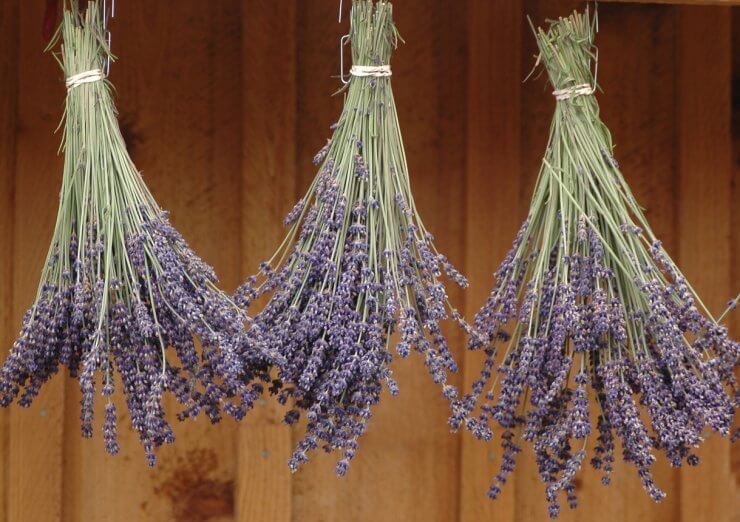
Lavender drying
Water
If you have fresh lavender flowers you’d like to use in a recipe but you’ve cut them ahead of time, you can keep them fresh for a few days in a glass of water. Trim all the leaves off the stem so no leaves are in the water. You can also wrap your lavender in slightly damp paper towels and store them in the fridge for a few days.
Drying
Preserving lavender is easy. The easiest way is to dry your harvested bunches by hanging them upside down in a warm, dark, dry room with good air circulation. This method preserves the lovely color of your lavender and keeps the stems from developing mold. They should be completely dry in two to three weeks.
Dried lavender for culinary use has a shelf life of about a year. When you’re ready to use it for cooking, roll the bud end of the stems between your hands over a bowl, or run your hand down the length of the stem to release the buds.
You’ll want to shake the buds in a sieve once or twice to dislodge any soil or dust. Then they’re ready to use. Store them in an airtight jar in a dark, dry spot.
When it comes to using lavender in recipes, keep in mind that dried lavender buds have two to three times the flavor intensity of fresh buds.
Oil
You can make a delicious lavender-infused oil to use in cooking and salad dressings. Use a mild flavored oil such as safflower, sunflower, or almond oil.
Fill a clear glass jar with freshly picked lavender stalks (buds or flowers) and cover them with the oil. Cover the jar with cheesecloth and let it steep on a sunny windowsill for about two weeks. Stir daily. After two weeks, strain the oil through the cheesecloth and see if you like the strength. If so, strain the entire jar into labeled bottles. If you want it stronger, pour that oil over a jar of freshly cut lavender and repeat the process. Keep the jars tightly sealed once you’ve gotten your oil to the strength you prefer and store you jars in a cool, dark place, such as a cabinet. How long your oil lasts depends on the type of oil you use. Check the oil label for shelf life—it could be a few weeks, or it could be up to a year or more.
Another method is to combine a half cup of chopped fresh lavender—stalks, flowers, buds, leaves, and all—with a cup of safflower or sunflower oil in a nonmetal pan (a glass saucepan works well for this). Heat the oil until the mixture is fragrant and warm, but don’t let it boil.
Strain into labeled bottles and store in the fridge. Since the lavender has been heated, it will begin to break down more quickly than the lavender in the method listed above. Use this heating method if you’re in a hurry to get your culinary lavender oil ready, and use it within a month. If you still have lavender on hand, you can use the slower extraction method to make some longer-lasting oil.
Vinegar
Vinegar is another excellent way to preserve the flavor of lavender. Use freshly cut lavender stalks harvested in the morning, at the peak of freshness. Rinse them thoroughly and let them dry completely.
Put the lavender stalks into a wide-mouth jar and pour rice or cider vinegar over them to cover the plant material completely. Put a piece of waxed paper between the jar and the lid to get a good seal.
Let the jar sit in a cool dark place for a week to several months; the longer it sits, the stronger it will be. Be sure to label your jar so you know when you started the process. Don’t let it sit for more than six months.
When you’re ready, use cheesecloth, muslin, or a paper coffee filter to strain the lavender from the vinegar. If you like, you can put a fresh sprig of lavender in the jar as decoration.
Keep the jar tightly closed and store in a cool, dark area. Use within six months.
How frequently do you harvest your lavender? Please tell us what you look for when getting ready to harvest, and how you preserve your harvest.


 Previous
Previous

